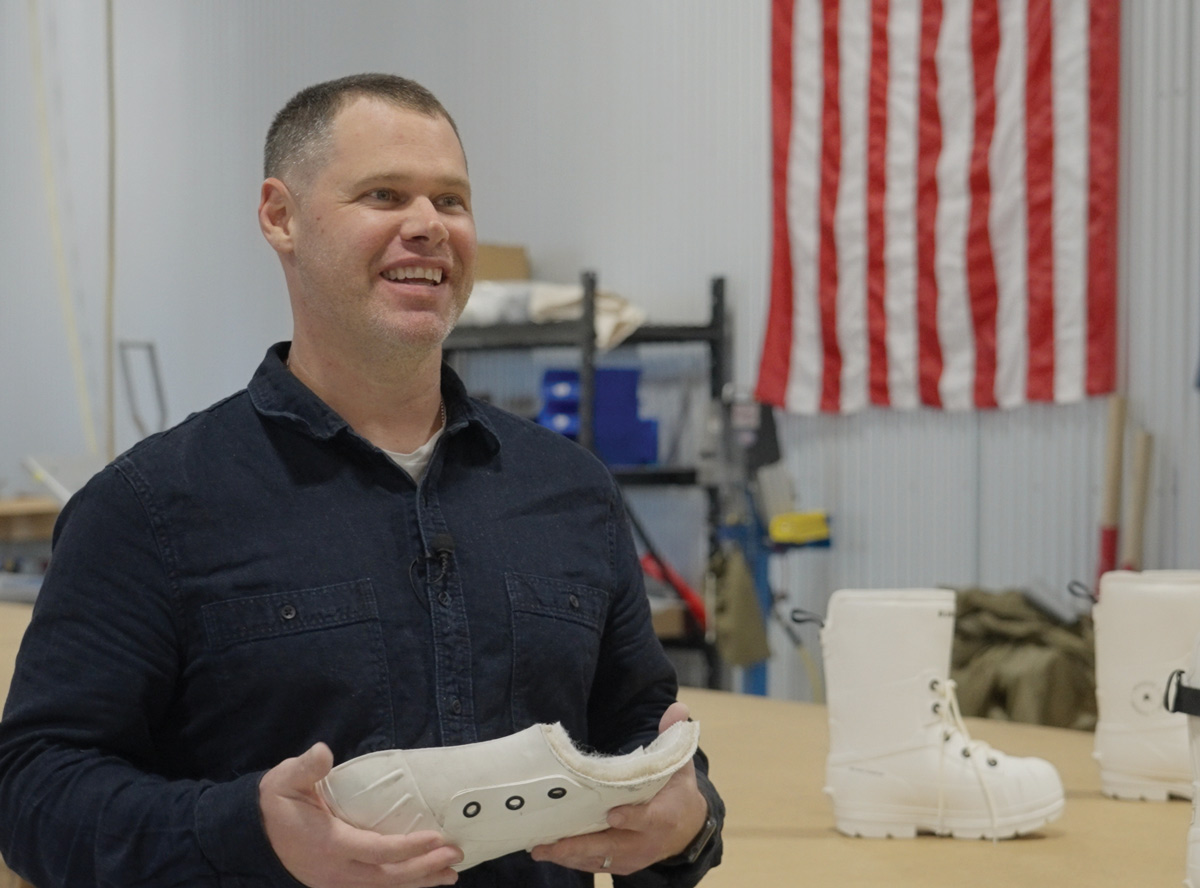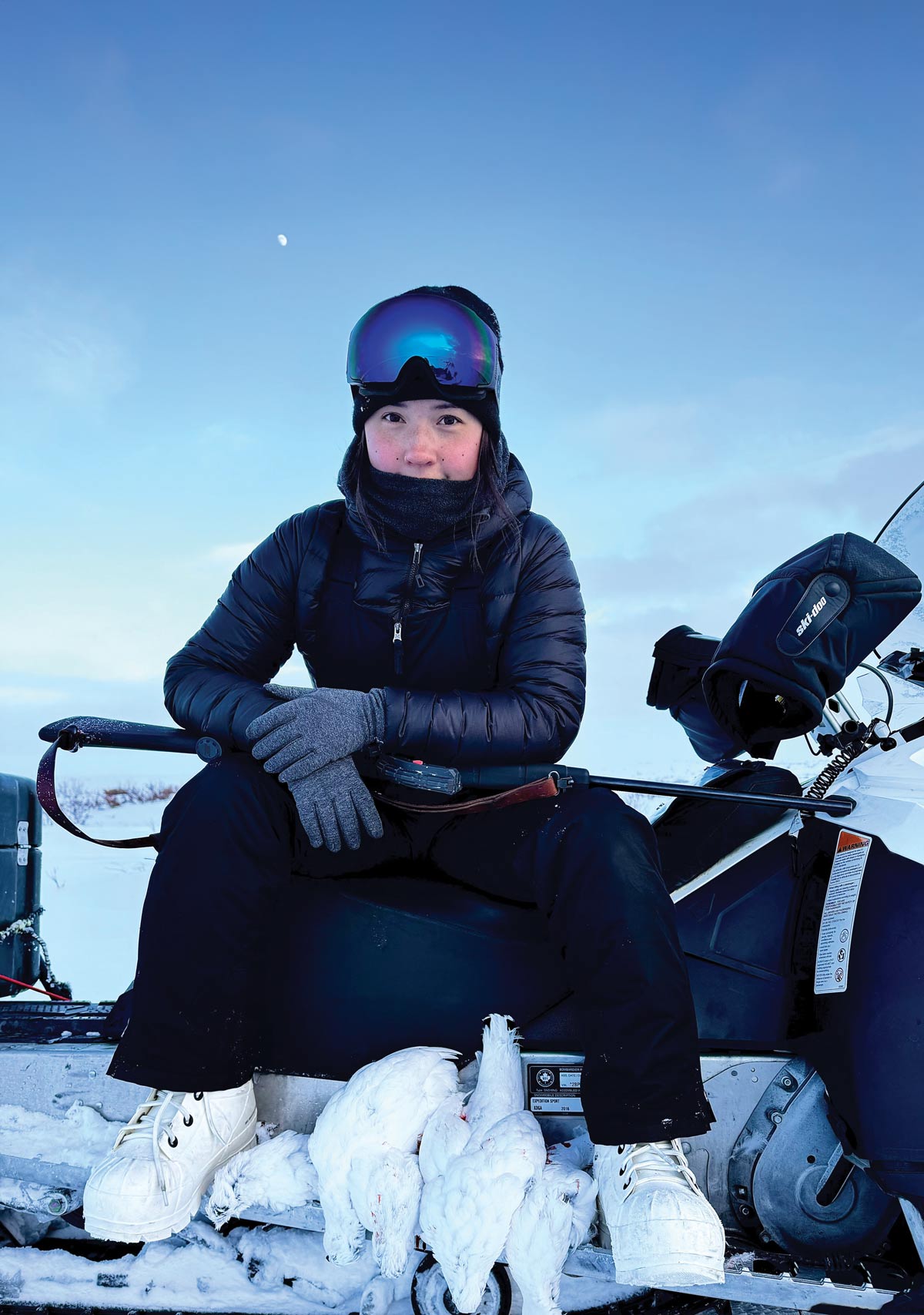fter several years of product design and engineering, Alaska Gear Company has begun field testing a modern version of the iconic “bunny boot,” solidifying its brand as a manufacturer of gear for tough environments. Field testing will demonstrate how the product performs under real-world conditions, especially compared to the original bunny boot.
Extreme Cold Vapor Barrier Boots were developed for the US military in the ‘50s. White and oversized like a rabbit’s foot (hence the nickname), the design has been modified over the years, such as the inclusion of an air valve to keep the boots from rupturing in underpressurized aircrafts or high altitudes. Over the decades, bunny boots have been synonymous with warmth and protection in the harshest environments.
Constructed with a well-insulated interior and waterproof rubber exterior, bunny boots are rated to -60°F in cold, dry climates. They are considered the ultimate cold weather footwear because of their functionality, durability, and ability to protect feet in extreme temperatures. This has made them the optimum footwear not only for military personnel but for civilian workers, outdoor recreationists, and regular consumers—especially in harsh Arctic environments.
Bunny boots haven’t been readily available to the public for many years, but Palmer-based Alaska Gear Company aims to fill the void. Its new and improved footwear—aptly called the Alaskan Bunny Boot—is an innovative take on the legendary boot.
How is the new bunny boot different from the old one? According to Sean McLaughlin, Alaska Gear Company’s owner and CEO, the Alaskan Bunny Boot has a taller shank and no air valve, which was a key point of failure in the older boots. It also has a more ergonomic fit, better traction, and an insole to help with the expulsion of moist air from inside the boot.
“The biggest difference is that you will actually be able to buy a new pair,” McLaughlin says. “But the design was originally from the 1950s. Much has changed since then in terms of science, materials, et cetera, so we just brought the product up to date.”
Alaska Gear Company sees itself as the prime business to reinvent bunny boots. The company—known as Airframes Alaska until it rebranded last year—manufactures a wide variety of aviation, outdoor living, and recreation products that give users better access to the true wilderness.
The company is well known for its Alaskan Bushwheels, tubeless tires that allow pilots to land light aircraft in unforgiving conditions. Alaska Gear Company also makes rugged Arctic Oven tents, Super Cub fuselage modifications, and custom fabricated sleds, including heavy duty Siglin freight hauling sleds and lightweight pulk sleds that people can pull behind on foot. As a recent addition, the company introduced a bolt-on TiSHX airplane suspension system that can be used out of the box without any calibration, providing an inventive solution for backcountry bush pilots looking for off-airport performance.
Alaska Gear Company fabricates parts at its factories in Palmer and Fairbanks. It also operates a retail store in Anchorage and has about eighty employees among all three locations. The initial large-scale production run of the Alaskan Bunny Boot, incidentally, is being outsourced to an overseas manufacturer whose name and location have yet to be disclosed. “There are no domestic producers for this type of boot; it is basically a science and art form lost to outsourcing,” McLaughlin says.
As a product, the Alaskan Bunny Boot aligns perfectly with Alaska Gear Company’s corporate mission and vision. “The guiding vision behind our company is ‘experiencing true wilderness,’ getting out into nature for extreme adventures,” McLaughlin explains. “Bunny boots are critical gear in that journey, and it was/is an unmet need. Also, boot making is similar to tire making, so we have unique experience and skills that will help with manufacturing. The market is unique enough that we think we can be profitable eventually making them in Alaska.”
Not only is boot making comparable to creating tires, but safety equipment demands the same sort of rigorous research and development process that aviation does, McLaughlin says. Thus, updating the original ‘50s bunny boot design—based on the latest science and materials—was a natural progression for the company.
Mark Britton, lead boot designer for Alaska Gear Company, says prioritizing functionality, durability, and weight had the trade-off of added manufacturing complexity, so the product cannot be made in Alaska just yet.
Alaska Gear Company

And it’s an endeavor Alaska Gear Company is taking very seriously. McLaughlin says, “This is a serious research and development project similar to the work we put into building airplane parts.”
Unmet need is clear, based on anticipation posted on Alaska Gear Company’s Facebook page. “Tired of looking for another pair of bunny boots, and only finding rotting derelicts at $500 a pair!” said Bud R Ogden in January. “Glad you guys are working on a new design.”
Sheri Elizabeth posted, “This is super exciting. I can’t wait to try them for ice fishing. My feet are always cold and if my feet are cold, I’m cold all over.” And Danny Drake said, “I travel all over the state, and everywhere I go people are talking about these boots and how excited they are to get some.”
The Alaskan Bunny Boot design is based on creating “forever” waterproof insulation that keeps feet warm no matter what happens—even if moisture compromises the insulation, according to boot designer Mark Britton.
“All materials and constructions were chosen for that goal and patterned for functionality, durability, weight, et cetera,” Britton says. “The boot is mainly composed of an outer shell of thin pieces of layered rubber, an inner layer of lofted and felted wool, and a waterproof footbed and lining.”

Alaska Gear Company
Britton continues, “The real advantage is that we have created a fully waterproofed, durable boot inside and out—a feature that no other boot on the market has and is really very difficult to achieve in the manufacturing process.”
Developing the Alaskan Bunny Boot presented a unique and complex design challenge for Britton. “This really was a very difficult boot to design for, one of the hardest of my career,” he says. “When the boot launched, I even had several older designers reach out to me to confess they had tried to create a similar product but had all failed in the manufacturing process for one reason or another. Sean and the Alaska Gear Company team have really created an awesome boot here, and I know it’s just the starting line for them and innovation in the cold weather space.”
Britton should know. Having been a footwear designer for twenty years and a size 9—the industry standard for footwear samples—he has personally tried on and corrected many hundreds, if not thousands, of shoes and boots over the years for best fit, he says. “There have been quite a few standards that have been developed over the 1,000-plus years of shoe making, the 150-plus years of making vulcanized footwear, and the 20-plus years I have been immersed in it,” he says.
Aside from improving standards, fit, and function in the initial prototypes, testing materials, waterproofing, and flexion, Alaska Gear Company is now in the process of testing a significant number of boots on a broad range of people and end-use cases before production. “These will further inform the final design and initial production, and I don’t anticipate the innovation and testing will stop there,” Britton says.
Alaska Gear Company spent two and a half years designing and engineering the Alaskan Bunny Boot to prepare it for the initial field testing. A diverse group of thirty individuals are evaluating the product, including a North Slope pipefitter, dog musher, wildlife biologist, ski coach, park ranger, reindeer herder, and several pilots.
Ben Parker, who has worked on the Trans-Alaska Pipeline System for many years, is one of the eager product testers. His approach to thorough testing involves a variety of activities, from working in Prudhoe Bay to doing mundane daily tasks.
Parker’s initial assessment is overwhelmingly positive: “So far, these boots are fantastic, giving the old bunnies a run for their money. They are fabulously comfortable, and warm in the coldest, harshest weather I can throw at them.”
Having worn classic bunny boots since he was a teenager, Parker can compare the new to the old. “A couple issues with the old boots are they aren’t always easy to slip on and off (if laced up tight), and your feet are drenched in sweat after an hour or two, especially when wearing them in warmer climates like driving,” he says. “The new bunnies are excelling at these challenges. All day long, in and out of buildings, warm to cold, they somehow wick away moisture from my feet. The design of the upper part of the boot allows for quick entry. Instead of slipping on my Crocs, risking my socks getting wet in the fresh snow, I’ll slip on the new bunnies to go out and warm up my truck. I have about a month left for testing and have more challenges left for them to fully prove themselves. So far, I think they are on track to be the best winter boot on the market.”
Thirty people, including pilots, a reindeer herder, a ski coach, and a pipefitter, are field testing the Alaskan Bunny Boot.
Alaska Gear Company

Bush pilot Jeremy Pepperd of Wasilla agrees. Pepperd—who flies for pleasure, not commercially—says the Alaskan Bunny Boot is an obvious improvement over previous versions of the boot. Traction is better, and the insole is a noticeable enhancement. Also, modifying the fit is as easy as adjusting the laces. “I’ve worn the original bunny boots for twenty-five to thirty years,” Pepperd says. “So far, the new ones are definitely more comfortable than the old ones.”
Pepperd has used Alaskan Bunny Boots in weather as cold as 15°F below zero, and he says they were effective at keeping his feet warm and resistant to wear and tear. “I have worn them about seven or eight times, and there are no scuffs or scratches—no damage whatsoever,” he says. “I think overall they are better than the original bunny boots. I think the final design is going to be hands-down better than what we’ve been used to.”
Collective feedback from field testing will help Alaska Gear Company refine its design and manufacturing techniques to ensure the best possible product, according to McLaughlin. The company hopes to bring the Alaskan Bunny Boot to market this year, with the ambitious goal of manufacturing the product in Alaska. “If the initial launch goes well, that will fund/fuel the building of a domestic factory in Alaska to make the boots long term,” he says. “If the whole plan works, we expect to domestically source all the materials for the boot. If we can do that, the US Army is interested in the boot as well, but they require domestic sourcing. So, like most entrepreneurial endeavors, this thing happens in stages as we test the market and then deploy capital.”
As the saga of the Alaskan Bunny Boot’s development continues to unfold, one thing is clear: this innovative product has the potential to redefine cold weather footwear and revive a legend for a new generation of users.